How to Tour Local Permaculture Sites – Part 1
Touring, photographing, and sharing permaculture gardens in my area seems like I task I will never get tired of. With that in mind, welcome to my new blog series.
I will be showcasing “official” tours as well as informal visits to existing and aspiring permaculture sites in the region. Learning from the ingenious little ways people connect to their ecosystem is so much fun! I’m looking forward to providing a database of area permaculture gardens that people can access from wherever they live.
The first garden on the tour is a home in Asheville, NC that has a three year old permaculture landscape designed by Zev Friedman. You can contact him and ask to be added to his email list if you’d like to be notified about his future group tours.
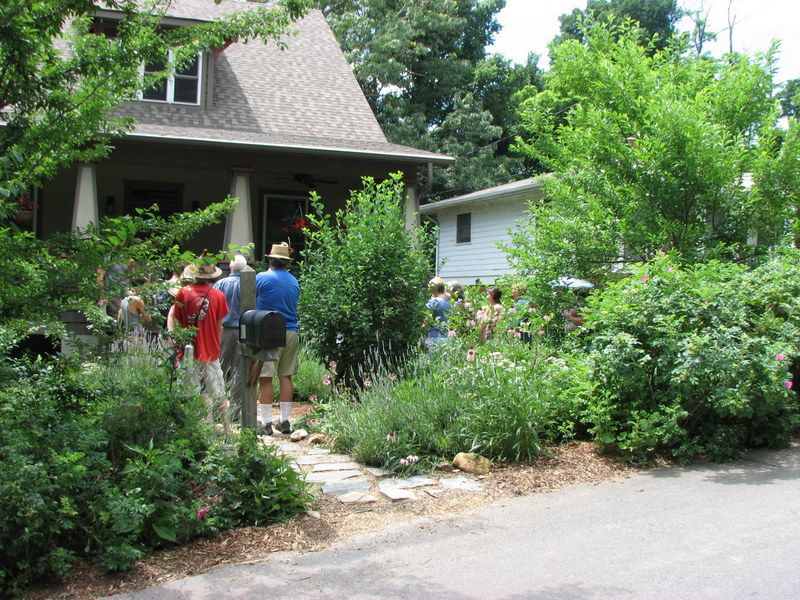
Photo Caption: I prefer visiting gardens with smaller groups than this, but it was fun to have Zev Friedman as our tour guide. He talked about all kinds of permaculture uses for plants but also covered a few other features like swales, a large water cistern, and future plans for a catchment pond.
This home was located on a downtown residential street in Asheville and fully exemplified how stunning a permaculture landscape can be. A yard this pretty makes it easy to win over the neighbors!
Plants on the property included white oak, plums, persimmons, apples, mulberries, serviceberries, hazelnuts, elderberries, aronia, raspberries, blueberries, fruiting roses, grapes, passionfruit, Jerusalem artichoke, strawberries, culinary herbs, lavender, horseradish, comfrey, begonias, sochan, tomatoes, echinacea, black-eyed Susans, lovage, yarrow, spiderwort, wood nettles, willow, mountain mint, yellowroot, euonymus, monarda, cup plant, coreopsis, and more.
Click the link to keep reading.
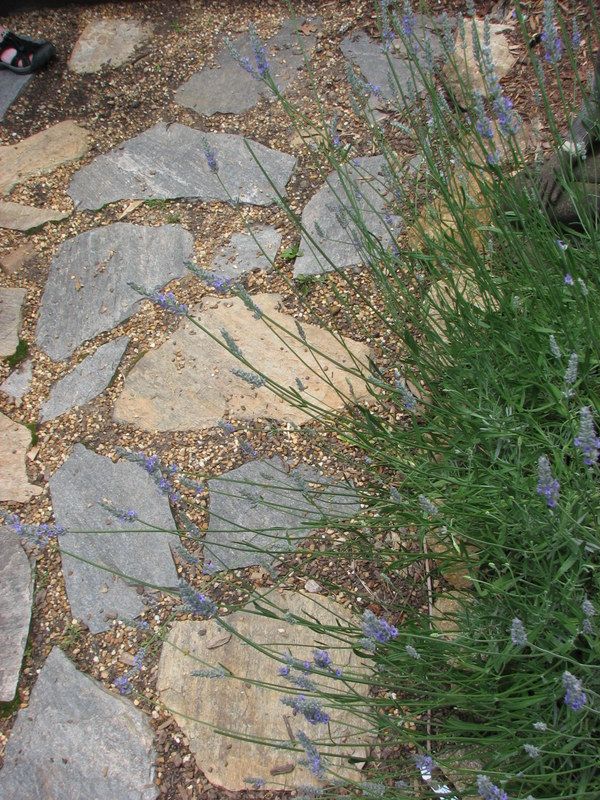
Photo Caption: This permeable walkway invites water to stay on the property instead of washing off in sheets.
Ponds, swales, and cisterns are usually the first thing to come to mind when considering water catchment. However, one of the cheapest ways to store water is in the soil and that means you need to make sure rain can be absorbed into the ground. Walkways, driveways, patios, and other hard surfaces don’t have to be solid. There are many water permeable paving options.
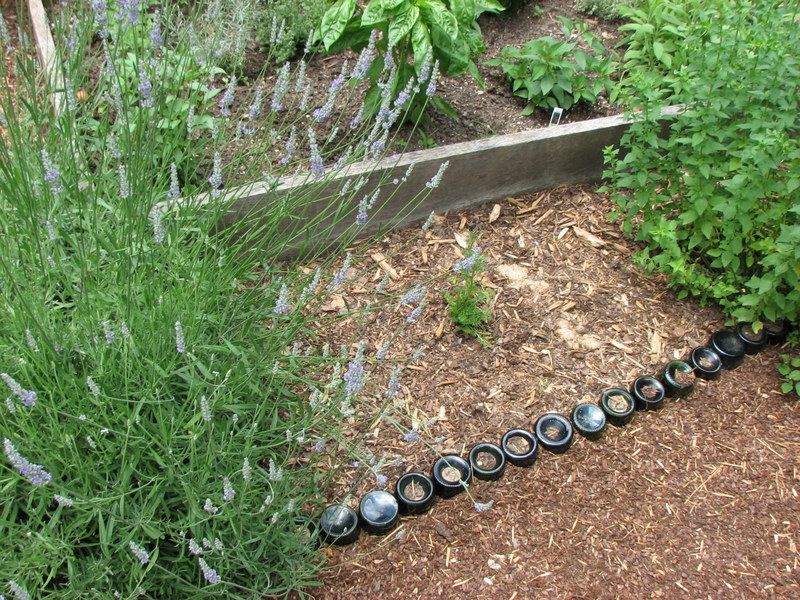
Photo Caption: Another important element of garden design is delineating paths from planting beds. Submerged bottles don’t work well as retaining walls, but they are great for making an edge more obvious.
Many people think paths are an afterthought, or even superfluous. That may be true on a large property where you aren’t carefully managing a growing area, such as a food forest. However, on the typical urban property this is unlikely to be the case — I’d venture to say that any property 1/2 acre or smaller needs to plan garden paths for every growing bed.
Why is this so important? Soil compaction causes serious, long-lasting damage to the health of your plants. Compacted soil retains less water, produces less plant nutrients, harbors more disease, and reduces the growth of roots. If you labored to “fluff” up those beds when you first planted, it makes even less sense to waste that effort by walking in it later. The key to great gardening isn’t how you treat your plants, it’s how you treat your soil.
One thing that is heavily affected by great, uncompacted soil is how fast your new plants will grow. This plum tree is over 10′ tall and loaded, in spite of only being planted three years ago.
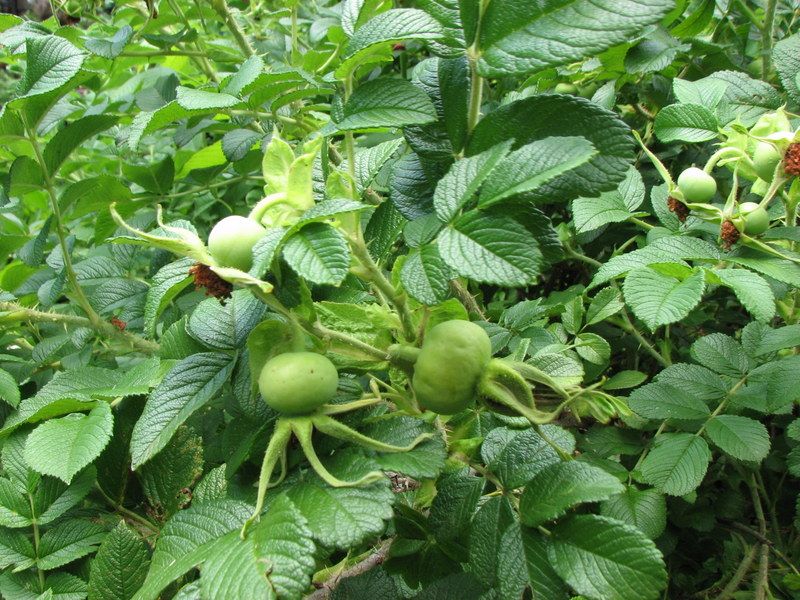
Photo Caption: Rosa rugosa makes fat, slightly flattened hips that are great for preserves and other uses.
The best roses are underused in American landscapes. Most of the time we plant spindly hybrid teas or scentless ‘Knockout’ types. Instead, try to find roses bred for a shrubby shape, naturally healthy foliage, and great hips. Rosa rugosa is a particularly hardy and fruitful species. Here’s a list of some exceptional roses for the southeast.
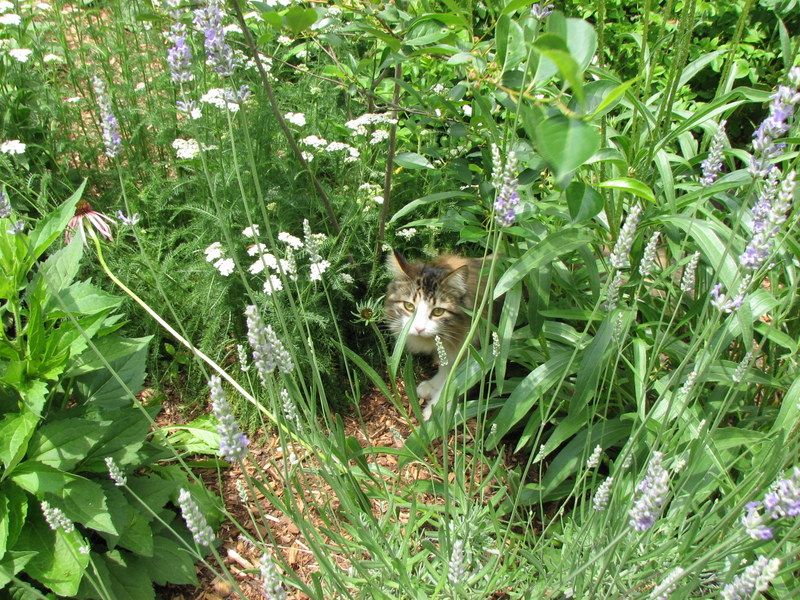
Photo Caption: Based on the dead vole that was laying on the walkway, this kitty is doing her garden chores. However, outdoor cats are indiscriminate about what they kill which makes them nearly impossible to balance in a permaculture ecosystem. Respectful discussion of this is welcome in the comments on this post.
Planting edible plants, flowering plants, and fertility plants intensively in the same bed is functional and beautiful at the same time. Well-matched plants make up what permaculturalists call “guilds.”

Photo Caption: The horseradish growing under this plum tree is accumulating nutrients with its deep tap roots.
Plants for permaculture guilds are chosen by attributes that make them work well together in the same space. In this photo you can see horseradish growing underneath a plum tree. The horseradish deters plum pests while also accumulating nutrients in the leaf litter.
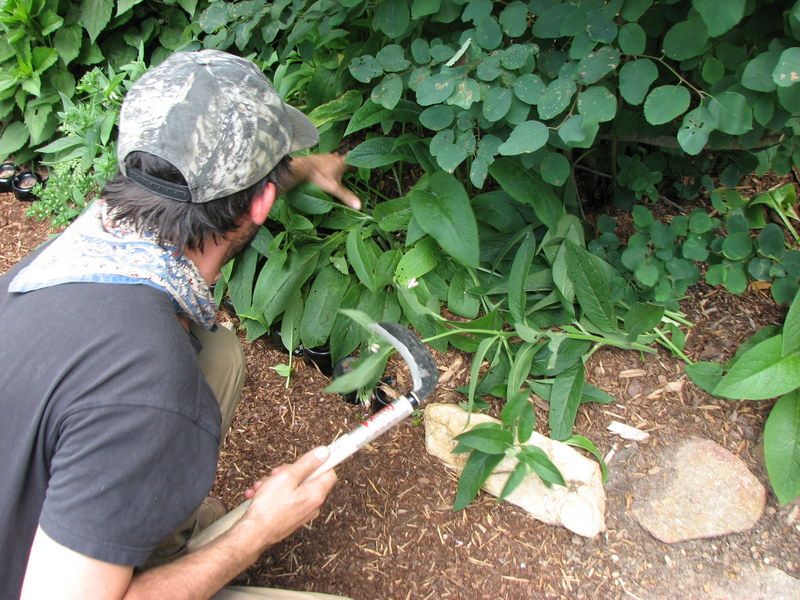
Photo Caption: Hand sickles are useful tools… unless you miss. Zev showed us a fat white bandage on his finger from a recent sickle accident.
Horseradish and comfrey can both be used as chop and drop mulches. Zev is shown using his hand sickle to cut comfrey tops as a nutrient-rich composting mulch for the surrounding plants. This can be done multiple times a year, since comfrey regenerates quickly.

Photo Caption: This is how a chop and drop mulch looks just after harvesting. You just leave the plant tops right where you cut them, unless you want to move them to a different bed. The comfrey leaves will break down into rich soil.
Comfrey mulch rapidly breaks down into rich soil, but in the meantime, it also protects soil organisms from UV light and conserves moisture. It’s rare to see a permaculture garden without comfrey.
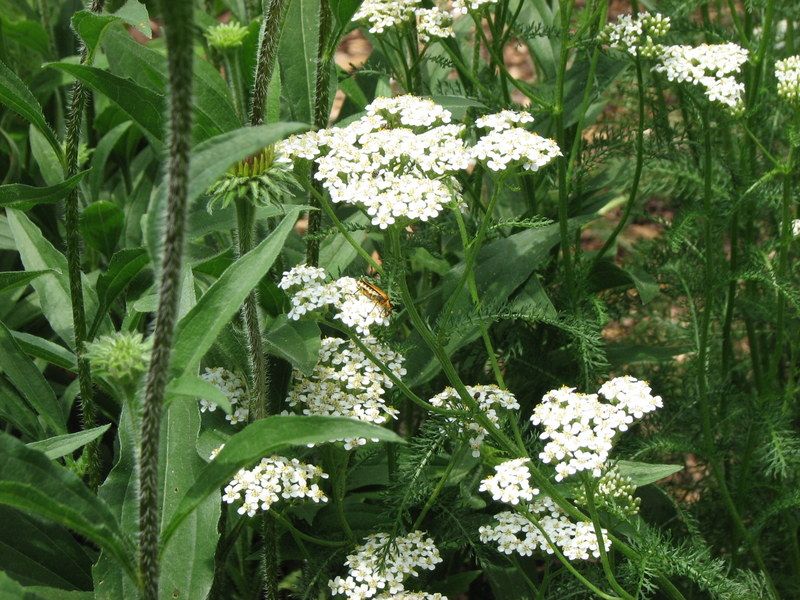
Photo Caption: Yarrow is a perennial plant that blooms over a long period. Its shallow flowers are great for attracting beneficial insect populations.
There’s a reason yarrow is one of the go-to plants for permaculturalists seeking beneficial insect attractors. The shallow nectaries of the tiny flowers are perfect for predatory insects like wasps, or the soldier beetle pictured here.
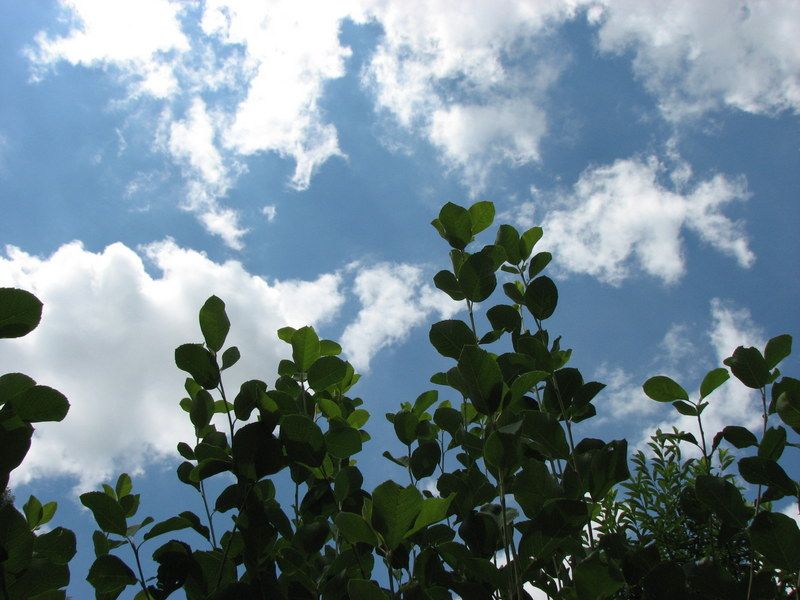
Photo Caption: Improving the soil enabled this serviceberry to tower over my head after only 3 years in the ground.
There are few small trees as attractive and useful as a serviceberry (also called a Juneberry). Although they resemble blueberries, they are more closely related to plums.
When people tell me they want something easy and edible to grow, I recommend blueberries. Unless the spotted wing fruit fly changes things, I can’t think of any plant with more reward for less effort.

Photo Caption: Which property would you prefer to live on? Edible shrubs, small trees, and herbs line the border between the two yards.
Spiderwort, raspberries, elderberries, hazelnuts, sochan, wood nettles, and more line a path that winds around the house into the backyard.
If you want to grow raspberries in your yard, check around to see if someone will give you some starts for free. Once established, they constantly reproduce by root suckers.
Asian persimmons sometimes struggle to get established after transplanting but once they have settled in they are mostly trouble-free. The shiny, tropical-looking leaves ensure an attractive specimen in the landscape. Many Asian persimmon fruits have the added benefit of not being astringent when unripe.
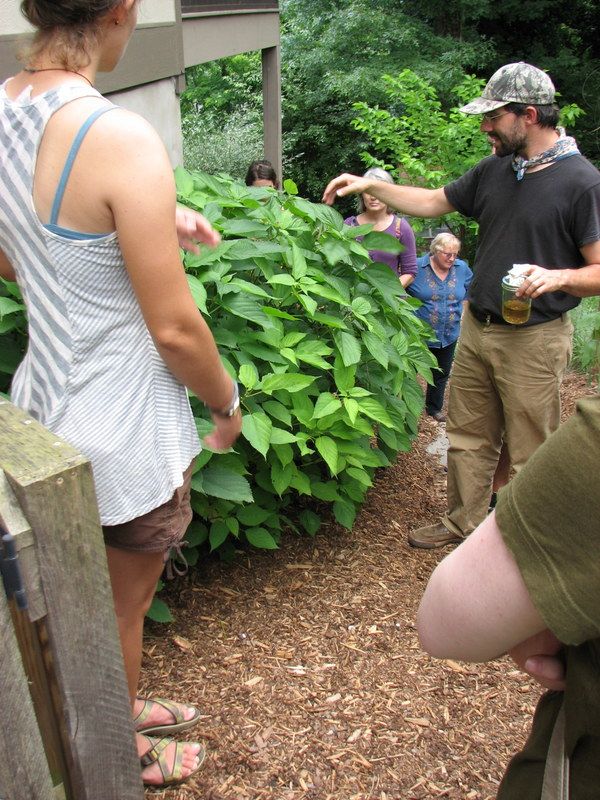
Photo Caption: Zev demonstrates how to pick wood nettles without being stung. Apparently, our native wood nettles are tastier and less injurious than the European variety.
I haven’t tried planting nettles yet but they are a healthy and tasty spring green (I’ve eaten them, and they’re yummy). Our native wood nettle, Laportea canadensis, is supposed to be superior in flavor and nutrition to common nettles, Urtica dioica. The “sting” can be avoided with gloves and disappears when cooked.
If you can beat the squirrels to harvest, hazelnuts are an excellent choice for permaculture gardens. Healthy fats and carbohydrates are our most difficult needs to supply from the garden and hazelnuts are nutritionally similar to olive oil.

Photo Caption: A water cistern rests at the top of this swale path and when it overflows, the excess water flows down the hill to the backyard.
Gardens on steep slopes have to contend with swift moving water and erosion. In this plan, the bank is covered in strawberries and comfrey to help retain the soil. Some of the elements in the design haven’t been added yet — a catchment pond will eventually replace the trampoline.
Strawberries often fruit the first year, but they give better harvests after their second season.
The chicken tractor resides at the top of the bank, which means it probably doesn’t do a lot of tractoring. Still, it’s helpful to be able to easily move a coop when needed.
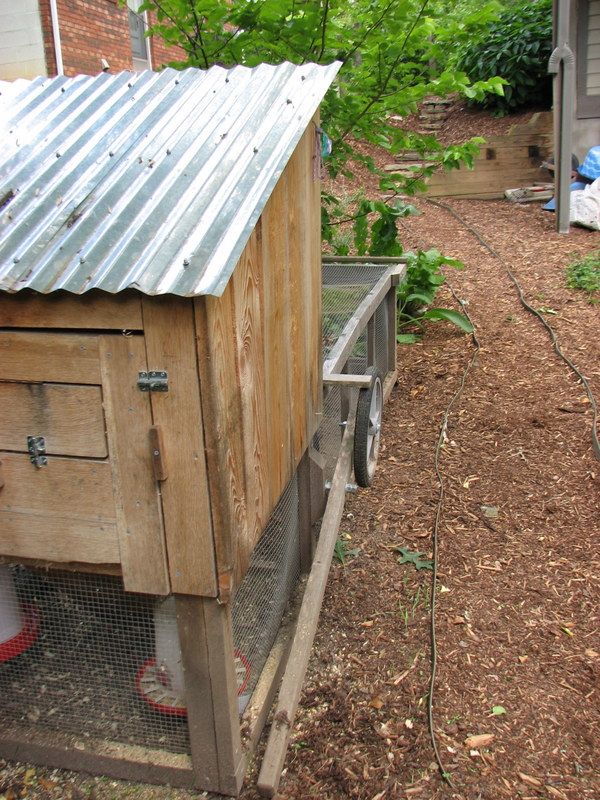
Photo Caption: A mulberry tree hanging over the chicken tractor drops unharvested fruit right at the hens’ feet.
Three to six chickens is a good-sized flock for a single family property in the city. Depending on the breed and age of the chicken, you get approximately 5 eggs a week per hen.

Photo Caption: How do you get a flock of chickens to stop showing their butts to the camera? Put a mulberry in front of them!
Mulberries are an excellent tree for coppicing. The cut limbs can be used for building, tinder, or animal fodder and the lower stature makes fruit easy to reach. Plus, no one ever sings about dancing around the mulberry tree.
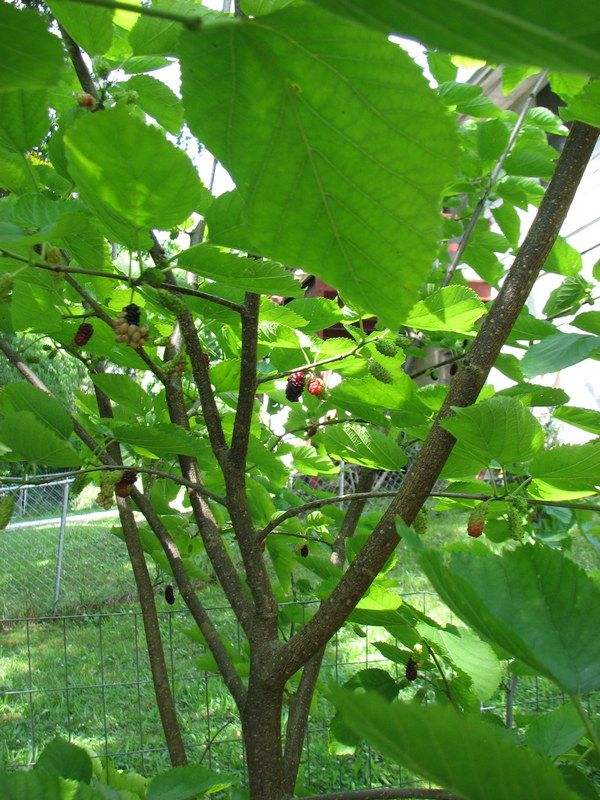
Photo Caption: If you let your mulberry tree get tall, the easiest way to harvest fruit is by shaking the tree over a tarp. Coppiced mulberries can be picked by hand.
Another tree that lends itself to human manipulation is the willow. They can be coppiced or simply woven into living sculptures.
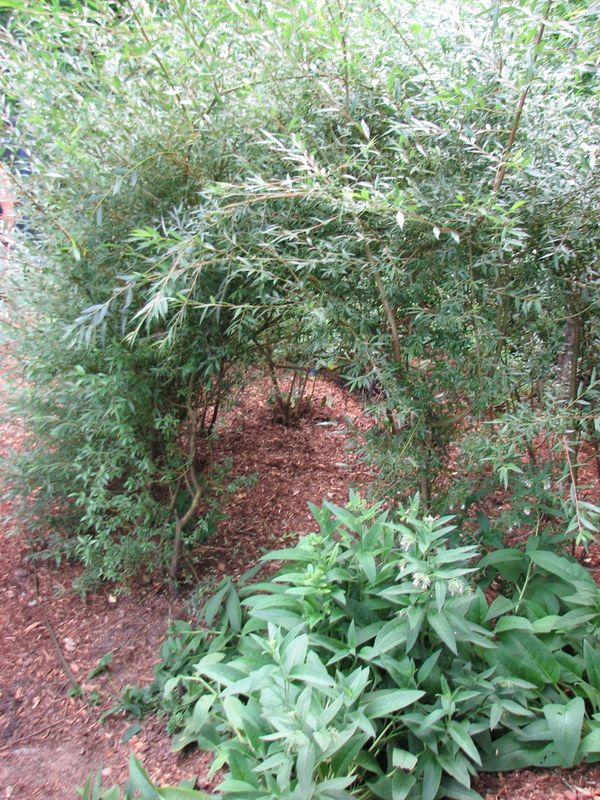
Photo Caption: This children’s play area is alive — made from woven willow trunks. The prunings can be used for weaving baskets, furniture, and more. You can also make a natural rooting hormone with willow.
A lot of the beneficial insect plants on the property were just on the verge of bloom, but this little coreopsis is well underway.
Monarda is another great multi-use plant. It attracts good insects and has culinary uses as an herb or tea.
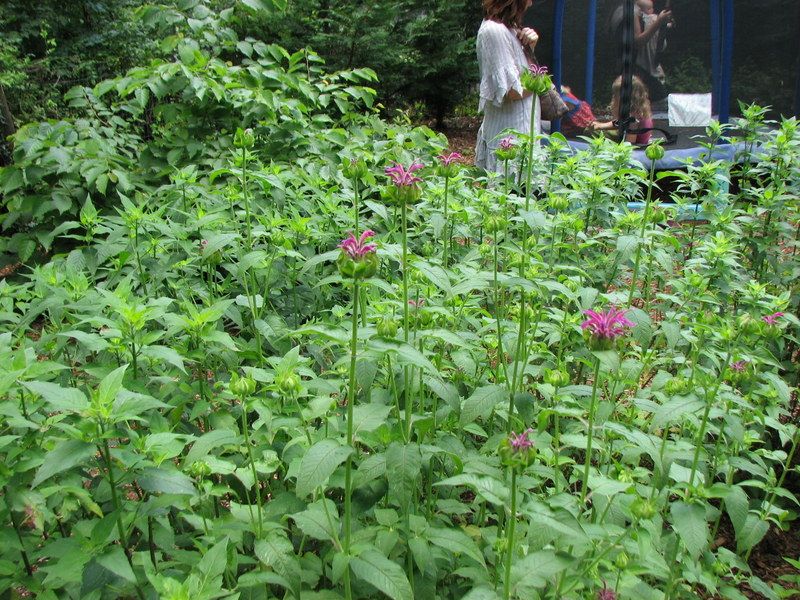
Photo Caption: Some monarda species are less prone to powdery mildew than others. Look for native species or the named variety ‘Jacob Cline.’
Hazelnuts don’t just offer a rare yield of oily nuts. You can use them as foundation plantings to help regulate the temperature of your home through the seasons. Since they are deciduous, the sun will reach the walls in the winter and help warm the house. In the summer, their dense foliage produces cooling shade.
Edible plants can work as well as ornamentals in social areas. Here hazelnuts, grapes, passionfruits, and apples create a beautiful “garden room” near the compost bins.
A ‘Honeycrisp’ apple hangs over a stone retaining wall. Apples can be fussy, but are not as difficult as peaches.
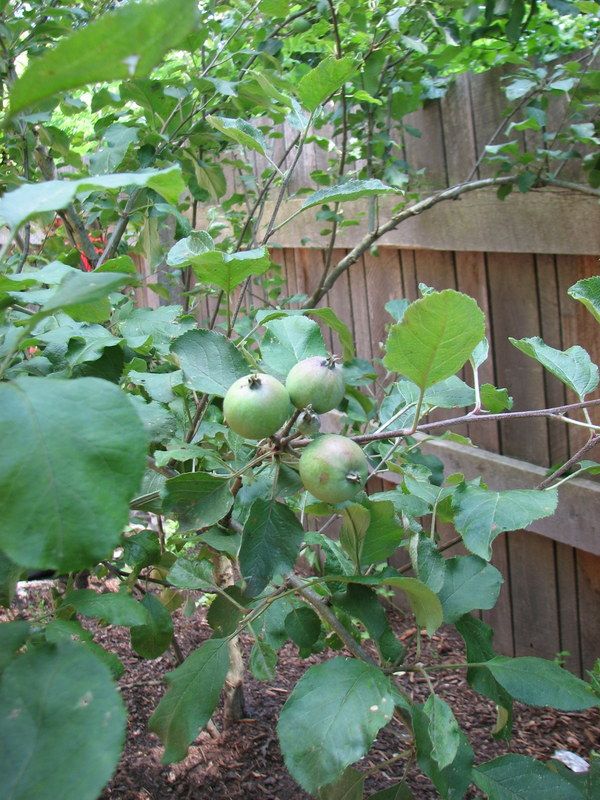
Photo Caption: If you want to grow apples, look for disease resistant varieties recommended for your region.
It’s best to give apples full sun and plenty of air circulation to reduce disease.
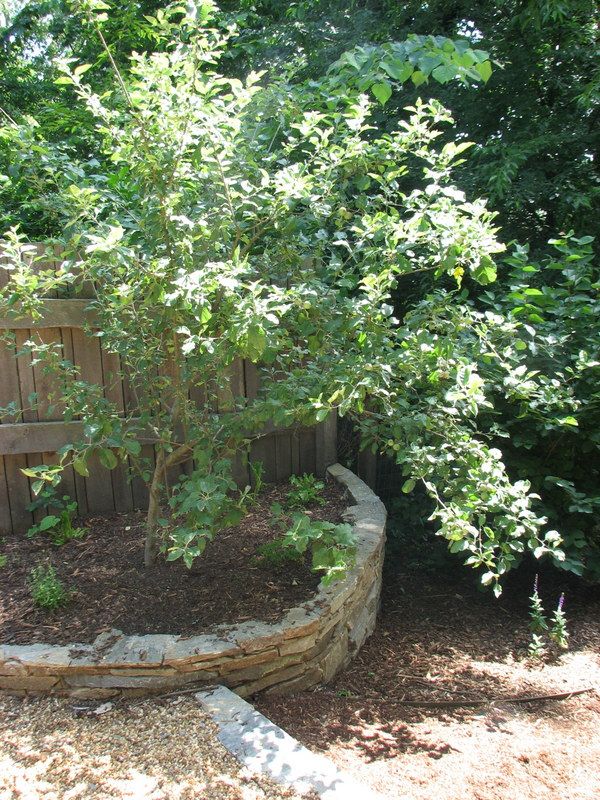
Photo Caption: This apple’s position near the path means that it won’t be crowded by other plants. Good air circulation helps with most orchard diseases.
Doorways and gates are good places to add an arbor for vining edibles like passionfruit, cucumbers, beans, malabar spinach, and groundnut. If the arbor is very strong you can grow heavier plants like hardy kiwi, muscadines, or hops.
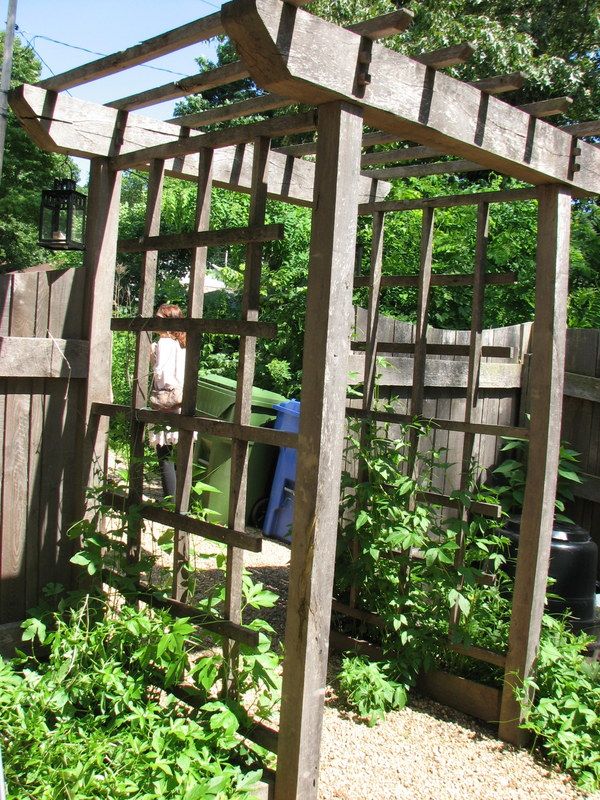
Photo Caption: Passiflora incarnata is our native passionfruit and it can either sprawl on the ground or use an arbor or trellis for support.
Good soil often supports large populations of worms, but a worm bin can be versatile and useful in a permaculture design. Sometimes you may want to use worm castings for a special application or harvest your worms for livestock food.

Photo Caption: Many commercial worm bins are available, or you can search for DIY plans and make one yourself.
I hope to see permaculture designs like this popping up in every neighborhood across the world. Wouldn’t it be nice if this was the norm, instead of the exception?
5 thoughts on “How to Tour Local Permaculture Sites – Part 1”
Comments are closed.
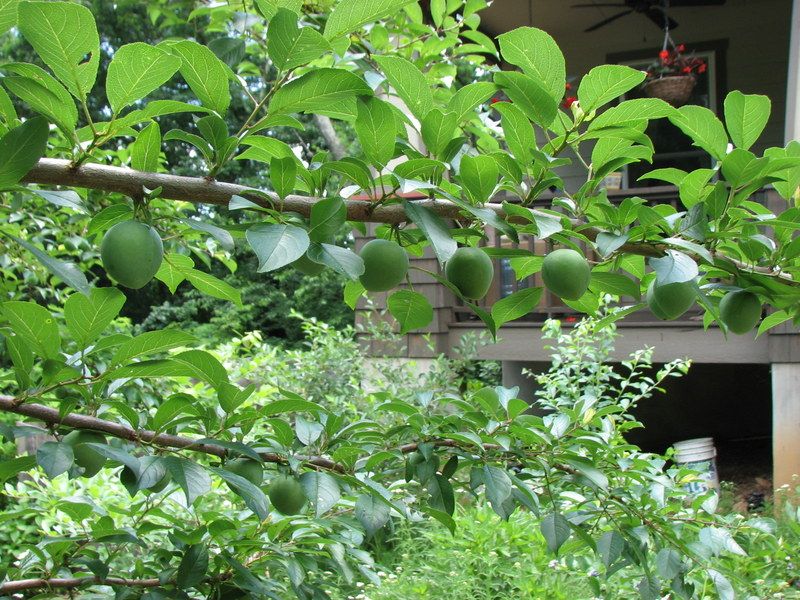
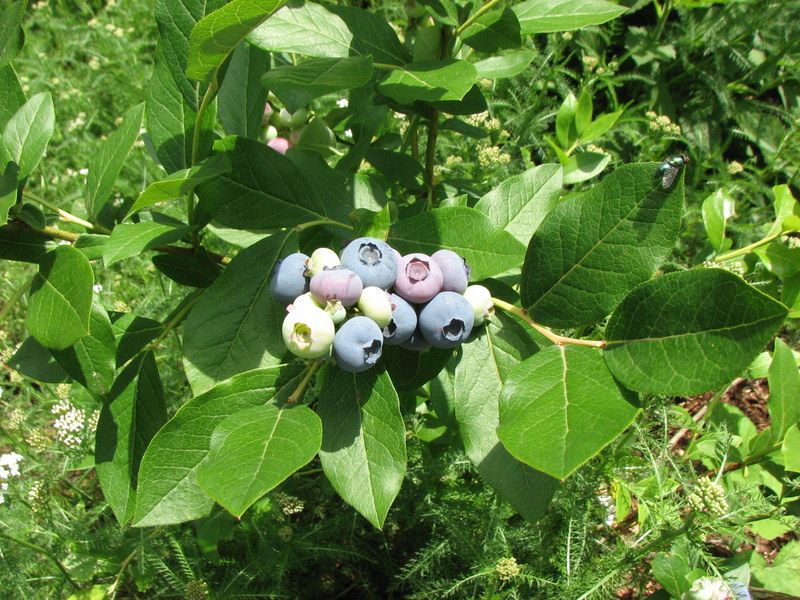
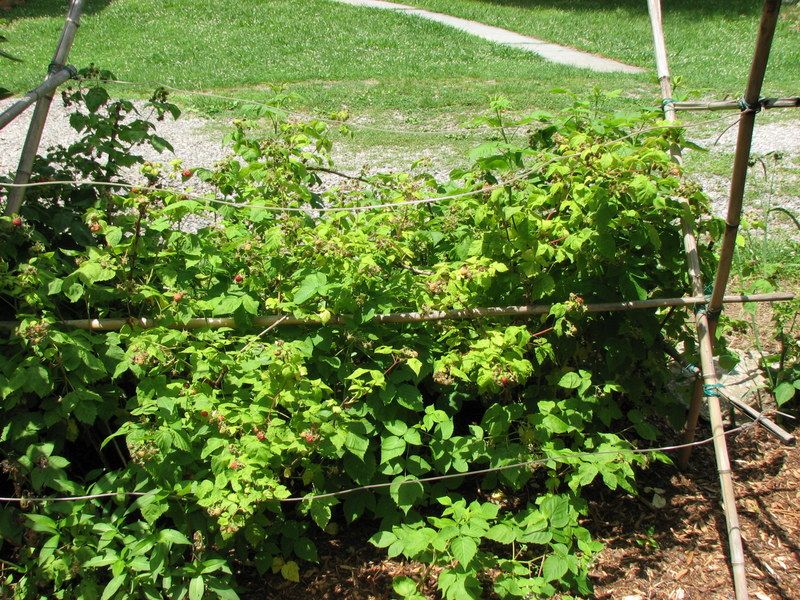
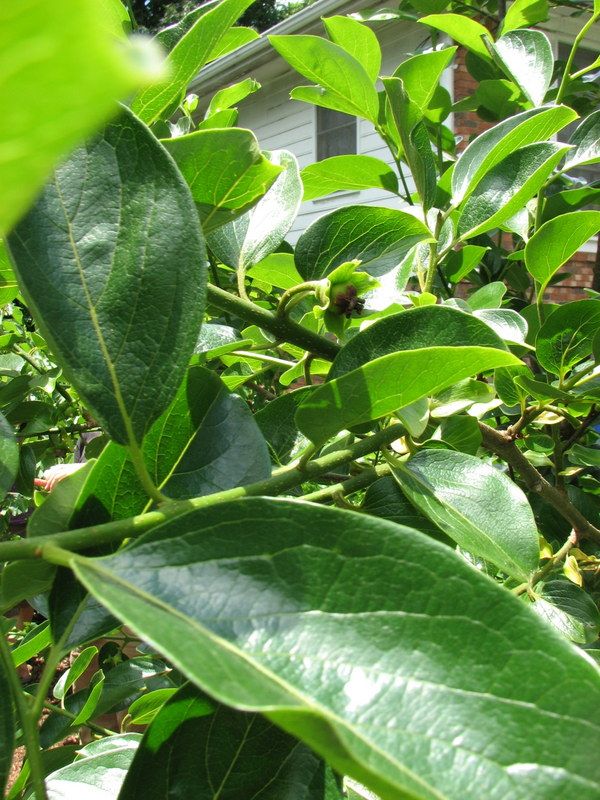


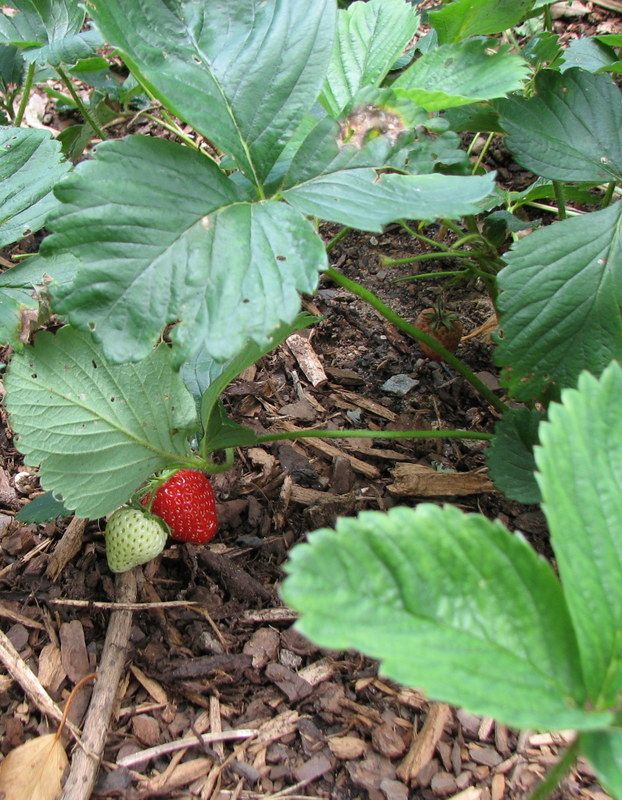
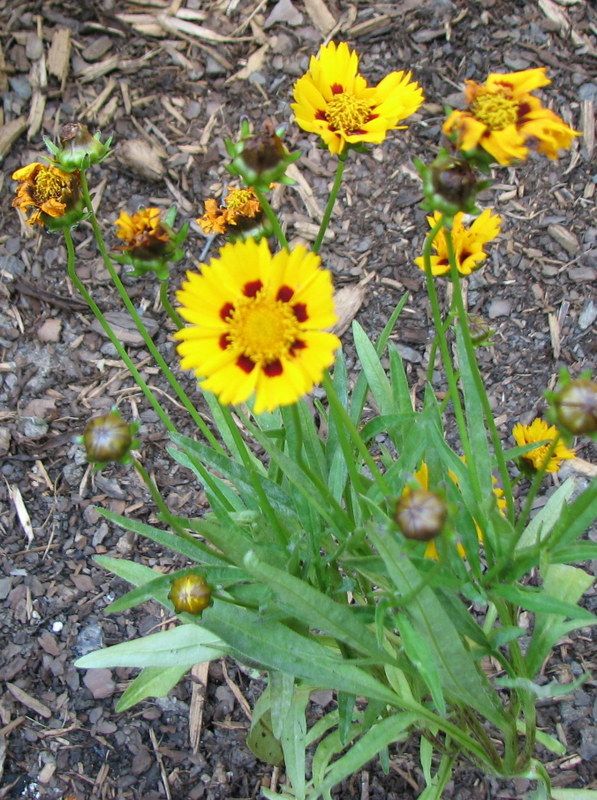
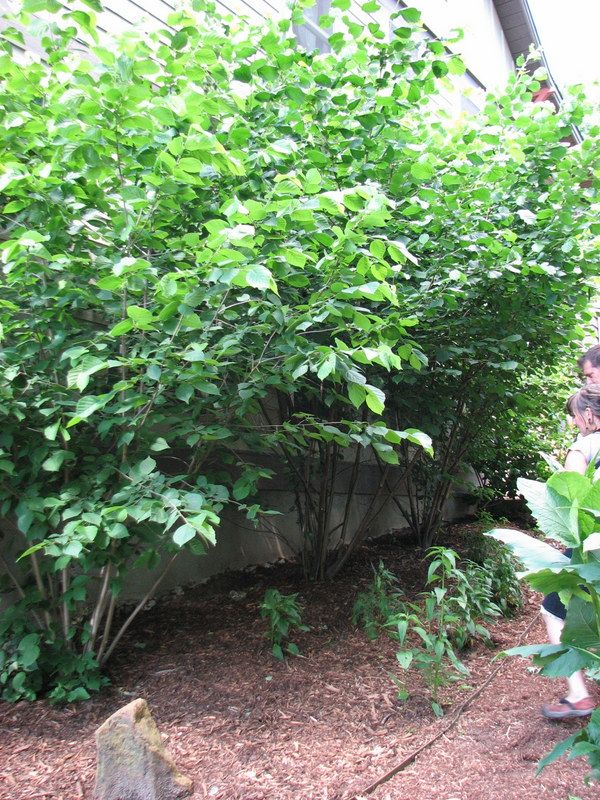


Donna - June 20, 2013 10:53 pm
What a great garden, very well planned. I love the chickens in the city and wish I could have some in my city too. They are a natural for such a well thought out space.
Donna´s last blog post ..Two Tales to Tell – Heron, Gull and Starlings
Eliza Lord
Twitter: appalachianfeet
- June 21, 2013 12:22 am
I received an email tonight regarding the cat mentioned in this article and the vole it killed. Since I tend to agree with the email (my cats are indoors only) I decided to share it.
I do know people who successfully use an electric fence to confine their outdoor cats to their garden (where voles are a problem… additionally, these same people have a neighbor who shoots cats which is an added incentive to keep them from roaming). However, in general I think cats are rarely in balance in their ecosystems.
As such, here’s the email I received, name withheld:
“Message:
I really enjoy your website and all the thoughtful and very useful
information you share. But you need more than a quick note on the fact
that cats are indiscriminate killers.
I love cats (have two) but they are now indoor only. We have five
acres in the upper Napa Valley. A year after we moved in we got two
outdoor cats to go with our one indoor cat. Within 8 months our female
was eaten by a coyote, but our male proved more formidable. In the
space of two years we had no Killdeers (ground nesters) left, and the
quail were gone in three or four years. From there Ernie killed many
gophers and moles, but also squirrels, owls, towhees, jays, flickers,
and many other birds, lizards, and even rabbits. After Ernie died it
took two or three years for quail to come back into the area and the
Killdeer never returned.
For more information goto
http://www.abcbirds.org/abcprograms/policy/cats/materials/predation.pdf
There is nothing natural about domestic cats and they have never been
a part of the natural environment. They are the only feline species
that kills when not hungry.
Thanks for listening to my rant.”
Donna@Gardens Eye View - June 23, 2013 7:54 pm
I learned so much from this article that i can do, and I also learned that I am doing many of these things…great to know.
Donna@Gardens Eye View´s last blog post ..Seasonal Celebrations Revealed-June 2013
Lynn - July 21, 2013 6:09 pm
Great article on a beautiful place. I’m really looking forward to your future trips that you will share with us. We’re heading further into our own woods to plant more and more foods in there because we’ve come close to running out of growing area on the 2 acres or so that is gardened, lawned, or pastured out. Personally, my favorite places are always wooded and a food forest, if we can pull it off, will give us more time to be out there!
Damaria Senne - December 7, 2013 9:50 am
Thank you for the post. I’m very new to gardening; still learning and setting up my garden really,and I would love for my garden to eventually develop into a permaculture site. It would help me, and eventually, my neighbours too, as food security is an issue around here.